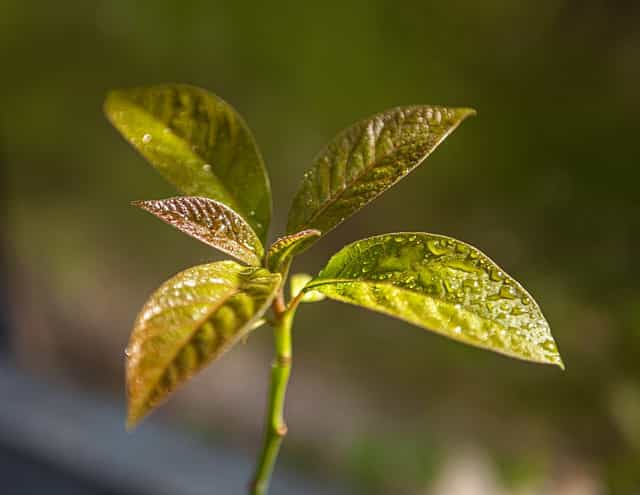Plant transplants are a risky business. Compare them to surgeries- a procedure that you need to perform with both delicacy and precision. Why do you ask? Here is why.
When moving a plant from one location to another, there is natural dislodgement of soil. The root structure is also compromised and requires time for redevelopment.
It is a crucial time for the plant- a period where it should have an ideal environment for rest.
Proper sunshine, avoiding excess moisture or an extremity of temperatures, regulated fertilization- these are a few measures generally taken to make a move smooth.
Why is my avocado plant wilting after a transplant?
To answer this question, you have to understand the science behind wilting. Leaves wilt when the roots are unable to access enough water.
The water is responsible for many things, one of them being the maintenance of the tautness of leaves. An absence of water pressure inside the leaf body leads to limpness.
There are a couple of probable reasons why roots are unable to draw an adequate amount of water. The first and most common reason is dry soil. Watering fixes this problem.
A graver problem would be if the roots underwent some damage. It would affect their ability to absorb water from the soil, thereby impeding an upward flow into the stem and leaves.
Although fixable, a damaged root structure is not an easy thing to fix. An improper transplant could very well lead to damaged roots.
When in the transplant process, the root hairs may tear off from the roots.
These root hairs, however minuscule, are responsible for the fast and efficient absorption of the water from the soil. An absence of these dramatically affects the water intake.
The general phenomenon of the adverse consequences of transplanting is known as a transplant shock. There can be several different reasons for a transplant shock, and most of them are easily preventable.
One of the most common causes for transplant shock is when the roots are overly disturbed during the moving process.
The rootball should be disturbed as little as possible- do not attempt to clean up the roots or snip off stray.
A common mistake made in conjunction often is an improper process implemented while digging up the plant.
Ensure that it is a clean, precise operation- with uprooting most of the root structure intact. It considerably lessens the chances of transplant shock.
Water, as mentioned earlier, is essential.
Overwatering does not cure a plant of shock sustained from the transplant, but ensuring that a certain quantity of moisture is maintained in the soil and around the rootball paves an easier path for the plant. Thorough watering is recommended, with breaks in between to prevent flooding.
Plants, as do all living objects, need time to acclimatize. Suppose you are transplanting to a different location where the light or temperature conditions are different.
In that case, it causes the leaves to droop from the stress of physically adapting to a new environment. A situation like this calls for thoughtful customization.
If the new surroundings happen to be warmer than the plant is used to, compensate by misting a couple of times a day along with your regular watering schedule.
Conversely, a colder than usual climatic condition might require the presence of a thermostat.
Apart from general preservation of the roots, a few other factors that need looking into include:
- Regular feeding.
- Protection from insect damage.
- Avoidance of cold drafts or much-too-warm loos.
- Immunity from disease.
What should one do if an avocado plant is wilting after the transplant?
There are a few ways to remedy a situation involving wilting due to an unsuccessful transplant. They are known to prove effective in most situations and are worth a shot.
1. Add Sugar
As odd as this may sound, a sugar solution is known to alleviate the effects of a transplant shock. It reduces the recovery time and helps create a soothing effect in the immediate environment of the plant.
Also, sometimes done during the transplant, a sugar solution is a trick you might want to try. Fret not; it never actively deters the recovery or growth of a plant.
2. Moist roots
A well-iterated point at this juncture in the article, moist roots are essential for a healthy transplant.
There are a few factors to be considered here- frequent watering, good drainage, and a watchful eye to avoid flooding.
3. Pruning
A common practice employed by gardeners, pruning after a transplant directs attention from the stems and branches to the roots.
The water supply then is concentrated on the roots, absorbed majorly by them, and leads to a faster regrowth of the root structure.
4. Timing
When you transplant has a lot to do with the amount of transplant shock the plant eventually sustains. Please do not wait until the root system has outgrown its current container.
It indicates that the structure is already well-developed and makes a clean transplant all the more difficult.
5. Additives
There are nutritional additives you can employ to relieve your plant from the shock and boost root growth. These include kelp fertilizers, beneficial fungi, and concoctions containing vitamin b and amino acids.
Conclusion
There is no guaranteed way to prevent something that is a recorded biological phenomenon.
No matter the amount of care involved when a transplanting ensues, there is a high probability that the plant in question will sustain a shock to a certain extent.
What matters is how you deal with the after-effects and the remedial solutions you can implement. Patience is key- it is essential to let the plant heal in its own time. Trying to rush along the process will only hinder an effective recovery.
Water the roots thoroughly, regulate the immediate environment to the best of your ability, and allow the plant to restore to its former health in due time.
